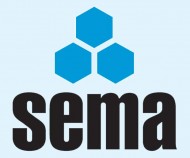On the basis of safety, SEMA completely opposes the use of cutting out and replacing sections of damaged uprights without offloading in order to save money on rack replacements. This method is not underwritten by any of the main rack manufacturers whose products are being modified or by the statutory authorities because:
 1. When a racking structure is purchased from a recognised SEMA member, it comes with a warranty based on independent testing to our recognised QAS 2000 quality assurance system which guarantees that the product has been designed, manufactured and installed to rigorously defined standards. The rack’s carrying capacity is based on this full circle of quality being in place and the Load Notice displayed normally carries the supplier’s full contact details for when advice is necessary.
1. When a racking structure is purchased from a recognised SEMA member, it comes with a warranty based on independent testing to our recognised QAS 2000 quality assurance system which guarantees that the product has been designed, manufactured and installed to rigorously defined standards. The rack’s carrying capacity is based on this full circle of quality being in place and the Load Notice displayed normally carries the supplier’s full contact details for when advice is necessary.
2. Once any third party modifies the installation, then any warranty and its carrying capacity becomes null and void as stated on the Load Notice. Any third party carrying out modifications then becomes liable for both the structural integrity of the racking structure and workmanship. SEMA codes of practice state that damage repairs must utilise a like-for-like product substitution to ensure that carrying capacity and rack safety are not compromised. So, any company modifying racking becomes responsible for defining the revised carrying capacity of the modified structure, so that the User can use the modified system safely.
3. While these alternative repair methods claim to offer a ‘safer working environment’, they completely ignore the document, BS EN 15635 Steel Static Storage Systems where Clause 9.7.1 states “Repairs to damaged equipment shall not be allowed unless approved by the equipment supplier”.
4. HSE guidelines in HSG 76 also state categorically in Clause 633 that “All racking systems should be of good mechanical construction, of sound material, adequate strength and installed and maintained in accordance with the manufacturer’s instructions.” No manufacturer to our knowledge will approve these types of repair to their racking.
5. Over the years, many repair methods have come and gone and this one is totally dependent on the quality of workmanship. That’s why BS EN 15635 notes that “Damaged components should be replaced rather than repaired, as effective quality is difficult on cold-formed materials.”
6. Even more foolhardy, claims are made that there is “no need to offload pallets in order to carry out repairs in this manner” which flies in the face of HSG 76 Clause 652 which states “where damage is identified which affects the safety of the racking system, the racking should be offloaded and controls introduced to prevent it being used until remedial work has been carried out.” Carrying out repairs on fully loaded racking is, in SEMA’s opinion, a highly risky procedure.
7. SEMA’s regular training courses for Maintenance Engineers recommend that as a minimum, the bay being worked upon together with the bay on either side is offloaded prior to any rack repair work. Where row spacers are fitted, it is imperative that racking in adjacent aisles is also unloaded. Surely it’s only prudent to recognise that a fully-loaded frame can be carrying a load of up to 40 tonnes, so if damaged, it’s probably far from safe! Risking a collapse while working on a damaged upright without unloading not only creates danger for the repair team, but also jeopardises the safety of all in the storage system’s vicinity.
‘Prop and Cut’ leg repairs are sold on the basis of speed and economy. But think carefully on IOSH’s mantra of “If you think safety is expensive, try having an accident.” Damaged racking means that there has already been one accident (or it would not have been damaged in the first place). So don’t compound the problem by risking unwarranted repairs on top. So just say no to ‘Prop and Cut’ Leg Repairs or allow the adage Caveat Emptor, meaning let the buyer beware, apply to your warehouse.





Comments are closed.